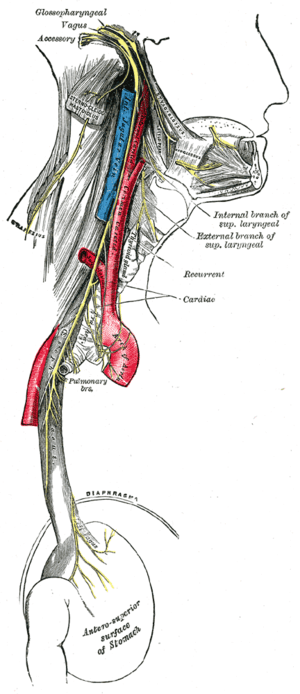Internal laryngeal nerve
| Internal laryngeal nerve | |
|---|---|
 Course and distribution of the glossopharyngeal, vagus, and accessory nerves. (Internal branch of superior laryngeal labeled at center right.) | |
| Details | |
| From | superior laryngeal nerve |
| Identifiers | |
| Latin | ramus internus nervi laryngei superioris |
| TA | A14.2.01.162 |
| FMA | 6240 |
The internal laryngeal nerve is the internal branch (ramus internus) of the superior laryngeal nerve. It descends to the thyrohyoid membrane, piercing it in company with the superior laryngeal artery, and is distributed to the mucous membrane of the larynx.
Of these (sensory) branches, some are distributed to the epiglottis, the base of the tongue, and the epiglottic glands; others pass posteriorly, in the aryepiglottic fold, to supply the mucous membrane surrounding the entrance of the larynx, and the mucous lining of the larynx as inferior as the vocal folds.
A filament descends beneath the mucous membrane on the inner surface of the thyroid cartilage and joins the recurrent nerve.
Above the vocal folds the sensory innervation of the larynx is via the internal laryngeal nerve. Below the vocal folds it is by way of branches of the recurrent laryngeal nerve. The vocal fold itself receives dual innervation from both nerves.
Pathology
Irritation of the internal laryngeal nerve results in uncontrolled coughing - usually as a result of food or water in the laryngopharynx.
Additional images
 The ligaments of the larynx. Antero-lateral view.
The ligaments of the larynx. Antero-lateral view.
External links
- -563412934 at GPnotebook
- cranialnerves at The Anatomy Lesson by Wesley Norman (Georgetown University) (X)